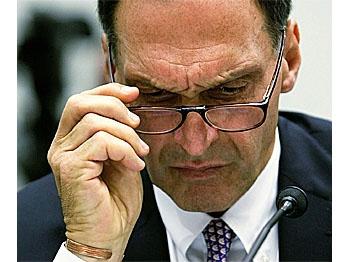The court examiner’s report on Lehman Brothers Holdings Inc.’s 2008 bankruptcy points extensively to an arcane accounting practice—referred to as “Repo 105” by the examiner Anton Valukas—as one of the ways the investment bank hid its true finances.
Lehman’s accounting firm Ernst & Young (E&Y) was privy to Repo 105, but had failed to raise it as an issue to the board of directors, according to the report published by Jenner & Block.
Essentially, Repo 105 is a sales transaction on repurchase agreements, which was used by Lehman to hide almost $60 billion of assets off-balance sheet. For Lehman, it held no business purpose and was solely done to hide assets and artificially decrease its net leverage ratio.
“Lehman did not disclose its use—or the significant magnitude of its use—of Repo 105 to the Government, to the rating agencies, to its investors, or to its own Board of Directors. Lehman’s auditors, Ernst & Young, were aware of but did not question Lehman’s use and nondisclosure of the Repo 105 accounting transactions,” Valukas said in the examiner’s report.
Some analysts point to Arthur Andersen LLP, formerly one of the “Big Five” international accounting firms, which neglected its fiduciary responsibility to the public by not disclosing Enron Corp.’s misleading accounting practices. The Enron debacle led to the downfall of Arthur Andersen.
The examiner’s report states that the London-headquartered E&Y was fully aware of Lehman’s Repo 105 use and remained silent about the nondisclosure in the financial statements.
The U.K. media has addressed E&Y’s responsibility, given the demise of Lehman, and is waiting to see if the audit firm will face malpractice or other claims.
The U.K.’s Financial Reporting Council (FRC), which oversees the U.K.’s financial reporting of public companies, recently asked E&Y to turn over all documents related to Lehman. It is looking for information showing that E&Y helped Lehman hide its borrowing activities for up to two years before bankruptcy filings, but only as far as any auditing done in the U.K.
But others, including E&Y, point to the fact that the demise of Lehman—which had more than $600 billion in assets—was not due to an accounting gimmick. Its massive investments in risky subprime and commercial mortgages, as well as rickety risk management, led to its collapse. Neither disclosing nor scrapping its Repo 105 transactions would have prevented the company’s downfall.
Franklin Allen, professor at the University of Pennsylvania, believes that any lender or other institution involved in Lehman’s Repo 105 borrowing activities must have understood that Lehman was operating on a shoestring and was misleading the public, rating agencies, and investors, according to a recent Knowledge@Wharton (KW) report.
Lehman needed favorable ratings from rating agencies for short-term borrowing, and Repo 105 made its balance sheet look leaner and reduced its net leverage ratio (the ratio of a company’s assets and liabilities to its equity).
“Lehman’s Global Financial Controller confirmed that ‘the only purpose or motive for [Repo 105] transactions was reduction in the balance sheet’ and that ‘there was no substance to the transactions,’” according to the examiner’s report.
When meeting with Lehman’s audit committee, E&Y did not address the Repo 105 use, although it had been advised about it by Mathew Lee, a senior vice president at Lehman, and was asked to discuss any possible improprieties committed by audit committee members.
“Ernst & Young took no steps to question or challenge the non-disclosure by Lehman of its use of $50 billion of temporary, off-balance sheet transactions,” Valukas said in the report. “Colorable claims exist that Ernst & Young did not meet professional standards, both in investigating Lee’s allegations and in connection with its audit and review of Lehman’s financial statements.”
Repo 105 is an accounting practice that has its roots in a rule called FAS 140 (Accounting for Transfers of Financial Assets and Extinguishments of Liabilities), was approved by the Financial Accounting Standards Board as a valid accounting practice in 2000, and has gone through some changes since its inception.
This rule allows a firm to sell its assets for a short period of time in return for cash with the stipulation to repurchase it shortly after for a set price. It is a borrowing activity that uses the asset as collateral. The asset generally does not lose value, provides an inexpensive interest rate because of the short borrowing window, and is a rather risk-free loan for the lender.
The rule’s intent was to protect investors, as the assets are no longer recorded on the books of the issuing company. Should the issuer run into problems, the new holder of the assets can sell them in the market, as the issuer is no longer the holder of the assets.
“Repurchase agreements were really loans, not sales, they did not fit the rule’s [FAS 140] intent,” according to the KW article.
The rule stipulated that the assets could not be removed from the books if the repurchase price stayed within a 98 percent to 102 percent range. If the assets’ price were not within that range, it would be a sale, and could be removed from the company’s books.
This type of accounting move could be construed as deceptive if used to hide the actual borrowing activities, but is legal under existing accounting rules.
The move is “very similar to what Enron did with their transactions. It’s called ‘round-tripping,’” said Brian J. Bushee, professor at Wharton School of Business, in the KW article.
To close a loophole that allowed firms to hide borrowing activities, FAS 140 was replaced with FAS 166 in June 2009.
The amended rule looks at the intent behind the transaction and whether it “truly involves a transfer of risk and reward. If it does not, the agreement is deemed a loan and the assets stay on the borrower’s balance sheet,” KW said.
Lehman’s accounting firm Ernst & Young (E&Y) was privy to Repo 105, but had failed to raise it as an issue to the board of directors, according to the report published by Jenner & Block.
Essentially, Repo 105 is a sales transaction on repurchase agreements, which was used by Lehman to hide almost $60 billion of assets off-balance sheet. For Lehman, it held no business purpose and was solely done to hide assets and artificially decrease its net leverage ratio.
“Lehman did not disclose its use—or the significant magnitude of its use—of Repo 105 to the Government, to the rating agencies, to its investors, or to its own Board of Directors. Lehman’s auditors, Ernst & Young, were aware of but did not question Lehman’s use and nondisclosure of the Repo 105 accounting transactions,” Valukas said in the examiner’s report.
Accountants’ Role
Some analysts point to Arthur Andersen LLP, formerly one of the “Big Five” international accounting firms, which neglected its fiduciary responsibility to the public by not disclosing Enron Corp.’s misleading accounting practices. The Enron debacle led to the downfall of Arthur Andersen.
The examiner’s report states that the London-headquartered E&Y was fully aware of Lehman’s Repo 105 use and remained silent about the nondisclosure in the financial statements.
The U.K. media has addressed E&Y’s responsibility, given the demise of Lehman, and is waiting to see if the audit firm will face malpractice or other claims.
The U.K.’s Financial Reporting Council (FRC), which oversees the U.K.’s financial reporting of public companies, recently asked E&Y to turn over all documents related to Lehman. It is looking for information showing that E&Y helped Lehman hide its borrowing activities for up to two years before bankruptcy filings, but only as far as any auditing done in the U.K.
But others, including E&Y, point to the fact that the demise of Lehman—which had more than $600 billion in assets—was not due to an accounting gimmick. Its massive investments in risky subprime and commercial mortgages, as well as rickety risk management, led to its collapse. Neither disclosing nor scrapping its Repo 105 transactions would have prevented the company’s downfall.
Playing the Ratings Game
Franklin Allen, professor at the University of Pennsylvania, believes that any lender or other institution involved in Lehman’s Repo 105 borrowing activities must have understood that Lehman was operating on a shoestring and was misleading the public, rating agencies, and investors, according to a recent Knowledge@Wharton (KW) report.
Lehman needed favorable ratings from rating agencies for short-term borrowing, and Repo 105 made its balance sheet look leaner and reduced its net leverage ratio (the ratio of a company’s assets and liabilities to its equity).
“Lehman’s Global Financial Controller confirmed that ‘the only purpose or motive for [Repo 105] transactions was reduction in the balance sheet’ and that ‘there was no substance to the transactions,’” according to the examiner’s report.
When meeting with Lehman’s audit committee, E&Y did not address the Repo 105 use, although it had been advised about it by Mathew Lee, a senior vice president at Lehman, and was asked to discuss any possible improprieties committed by audit committee members.
“Ernst & Young took no steps to question or challenge the non-disclosure by Lehman of its use of $50 billion of temporary, off-balance sheet transactions,” Valukas said in the report. “Colorable claims exist that Ernst & Young did not meet professional standards, both in investigating Lee’s allegations and in connection with its audit and review of Lehman’s financial statements.”
Accounting Trick Inherent in Repo 105
Repo 105 is an accounting practice that has its roots in a rule called FAS 140 (Accounting for Transfers of Financial Assets and Extinguishments of Liabilities), was approved by the Financial Accounting Standards Board as a valid accounting practice in 2000, and has gone through some changes since its inception.
This rule allows a firm to sell its assets for a short period of time in return for cash with the stipulation to repurchase it shortly after for a set price. It is a borrowing activity that uses the asset as collateral. The asset generally does not lose value, provides an inexpensive interest rate because of the short borrowing window, and is a rather risk-free loan for the lender.
The rule’s intent was to protect investors, as the assets are no longer recorded on the books of the issuing company. Should the issuer run into problems, the new holder of the assets can sell them in the market, as the issuer is no longer the holder of the assets.
“Repurchase agreements were really loans, not sales, they did not fit the rule’s [FAS 140] intent,” according to the KW article.
The rule stipulated that the assets could not be removed from the books if the repurchase price stayed within a 98 percent to 102 percent range. If the assets’ price were not within that range, it would be a sale, and could be removed from the company’s books.
This type of accounting move could be construed as deceptive if used to hide the actual borrowing activities, but is legal under existing accounting rules.
The move is “very similar to what Enron did with their transactions. It’s called ‘round-tripping,’” said Brian J. Bushee, professor at Wharton School of Business, in the KW article.
To close a loophole that allowed firms to hide borrowing activities, FAS 140 was replaced with FAS 166 in June 2009.
The amended rule looks at the intent behind the transaction and whether it “truly involves a transfer of risk and reward. If it does not, the agreement is deemed a loan and the assets stay on the borrower’s balance sheet,” KW said.







Friends Read Free